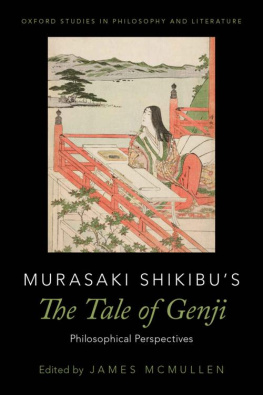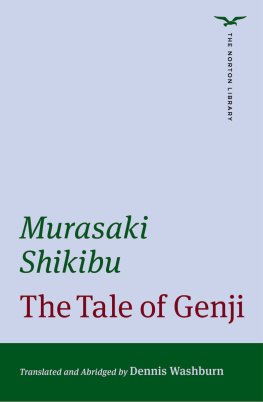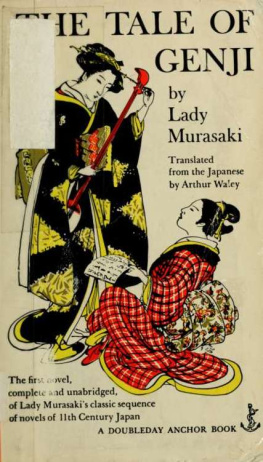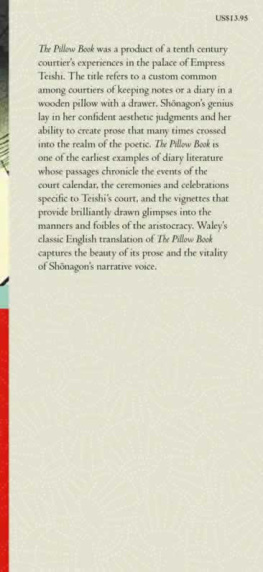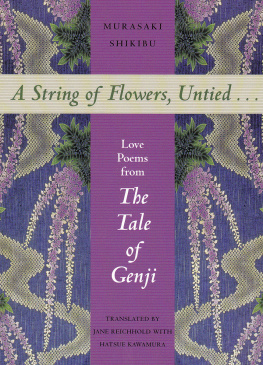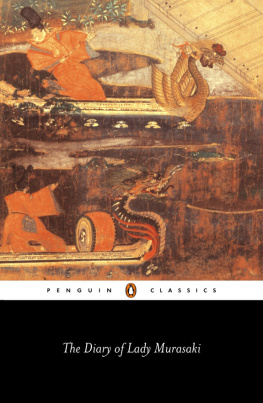Shikibu Murasaki - The Tale of Genji
Here you can read online Shikibu Murasaki - The Tale of Genji full text of the book (entire story) in english for free. Download pdf and epub, get meaning, cover and reviews about this ebook. year: 2013, publisher: Knopf Doubleday Publishing Group, genre: Art. Description of the work, (preface) as well as reviews are available. Best literature library LitArk.com created for fans of good reading and offers a wide selection of genres:
Romance novel
Science fiction
Adventure
Detective
Science
History
Home and family
Prose
Art
Politics
Computer
Non-fiction
Religion
Business
Children
Humor
Choose a favorite category and find really read worthwhile books. Enjoy immersion in the world of imagination, feel the emotions of the characters or learn something new for yourself, make an fascinating discovery.
- Book:The Tale of Genji
- Author:
- Publisher:Knopf Doubleday Publishing Group
- Genre:
- Year:2013
- Rating:3 / 5
- Favourites:Add to favourites
- Your mark:
- 60
- 1
- 2
- 3
- 4
- 5
The Tale of Genji: summary, description and annotation
We offer to read an annotation, description, summary or preface (depends on what the author of the book "The Tale of Genji" wrote himself). If you haven't found the necessary information about the book — write in the comments, we will try to find it.
The Tale of Genji — read online for free the complete book (whole text) full work
Below is the text of the book, divided by pages. System saving the place of the last page read, allows you to conveniently read the book "The Tale of Genji" online for free, without having to search again every time where you left off. Put a bookmark, and you can go to the page where you finished reading at any time.
Font size:
Interval:
Bookmark:
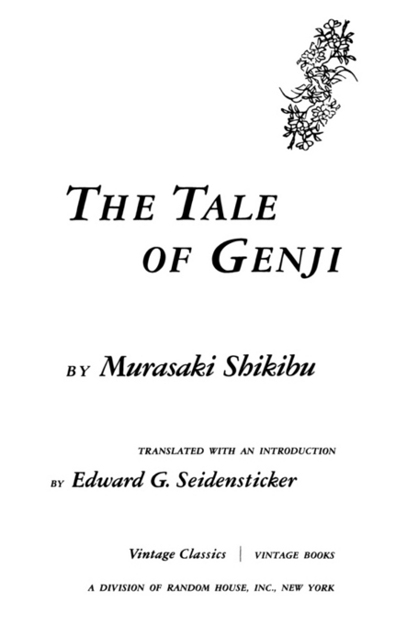
Vintage Classics Edition, June 1990
Copyright 1976, 1985 by Edward G. Seidensticker
All rights reserved under International and Pan-American Copyright Conventions. Published in the United States by Vintage Books, a division of Random House, Inc., New York, and simultaneously in Canada by Random House of Canada Limited, Toronto. Originally published, in different form, by Alfred A. Knopf, Inc., in 1976. This edition originally published by Vintage Books, a division of Random House, Inc., in 1985.
Library of Congress Cataloging in Publication Data
Murasaki Shikibu, b. 978?
The tale of Genji.
Originally published: New York:
Knopf, 1976
I. Title.
PL 788.4.G415E5 895.631 84-40519
eISBN: 978-0-307-83352-5
The woodcut illustrations reproduced in the text were first published in 1650 in the Illustrated Tale of Genji (Eiri Genji Monogatari). They are the work of Yamamoto Shunsho, a Kyoto artist who lived from 1610 to 1682 and who is best known for his work in lacquer.
v3.1

THE VINTAGE EDITION
This book, which contains a dozen chapters from early in The Tale of Genji, is about a quarter the length of the complete edition. The last chapter is the seventeenth chapter of the original. Chapters 2, 3, 6, 15 and 16, which stand apart from and have no effect on the main narrative, have been omitted.
Because Arthur Waley originally published his translation in six volumes, fairly regularly spaced over the years, the impression seems to be widespread that The Tale of Genji is a series of independent but related novels, like the Barchester novels or the Palliser novels of Trollope. This is an error. The six-part division is entirely Waleys, having no relation to the original, which is divided only into fifty-four chapters, and which is a continuing story. Waleys abridgment, which includes only the first nine chapters of the complete Genji, was published in a separate volume as if it brought the action to some sort of conclusion. It does not so serve. It merely takes the story an arbitrary distance and no further.
This selection is perhaps equally arbitrary, but it also has behind it the assumption that it would be well to get as far along with the story as possible, while keeping the selection to a manageable length. For this reason certain chapters not essential to the main, continuing story have been omitted. It seemed obvious that the beginning should be at the beginning, since the opening chapters are the only ones that do not depend on others for thorough understanding.
The ninth and last chapter of the shortened Waley version is inconclusive. It brings no resolution, for instance, of the political conflict between the factions of the Left and the Right. That conflict comes to a climax and resolution in the following chapters, treating Genjis exile and return. Chapter 17, with which this new version ends, may seem equally irresolute. In fact, however, what may be read as no more than a trivial dalliance for the diversion of a child monarch is an intense political struggleending with victory for Genji. Thus we see him fully rehabilitated, back from exile and deeply involved in affairs of state.
The second chapter (the fourth of the original) stands apart like those here omitted, but I have included it for two reasons: it is far superior to any of the deleted chapters, and it does come to affect the main narrative, because the daughter of the lady of the evening faces presently emerges from obscurity to assume an important role. The careful reader will see that only it among our dozen is closely akin to the deleted chapters. Added annotation was needed to clarify references to these chapters, and the last three pages, which harken back to the second and third chapters and seem to bring the cycle to a close, have been deleted. Nothing has been required by way of explanation or excision in the other eleven.
Offered the prospect of emendation, I was able to find and correct a number of errors from the original edition.
Not much can be said with certainty about The Tale of Genji except that it is a very long romance, running to fifty-four chapters and describing the court life of Heian Japan, from the tenth century into the eleventh. Very probably it was completed in something like its present form during the first quarter of the eleventh century. Except for fragments, the earliest surviving texts are from upwards of two centuries after the probable date of composition, and so textual problems will always remain to delight and occupy scholars; but the Genji is probably the work of a single hand, that of a court lady known as Murasaki Shikibu, with possible accretions during the two following centuries, not of sufficient magnitude to change the shape of Murasaki Shikibus original. At least one chapter is widely thought to be spurious, and two others are also suspect. It is possible too that chapters have been lost, but that the work consisted of more than fifty chapters by the decade of the 1020s is apparent from the Sarashina Diary, written in the mid-eleventh century by another court lady.
Precise information about Murasaki Shikibu is equally scant. We do not know her personal name, though scholars have delighted in speculating upon it. In Heian Japan it was bad manners to record the names of wellborn ladies, except, curiously, imperial consorts and princesses of the blood. Of the sobriquet by which she is known today, the second half, Shikibu, designates an office held by her father. Murasaki may derive either from the name of an important lady in the Genji itself or from the fact that it means purple, and fuji, the first half of her family name, means wisteria. She came from a cadet branch of the great Fujiwara family, which ruled the land in the name of successive emperors through most of the Heian Period. She and Fujiwara Michinaga, the grand chancellor who dominated court politics in the early eleventh century, had a common ancestor in the paternal line six generations back, but her branch of the family had by the time of her birth fallen to the second level of the court aristocracy. Her father occupied modest positions in the capital and twice served as a provincial governor.
Provincial governors are generally treated with contempt in The Tale of Genji Their layer of the aristocracy did more for the literature of the day than any other, however, and the usual view is that it was an uncommonly fine day, and that the Genji itself is the supreme masterpiece of Japanese prose literature. Why the literature of mid-Heian should have been dominated by women is another problem that exercises the scholars. Possibly it has something to do with the fact that Japan seems to have been relatively free of the harem politics that so beset other Oriental countries, and talented ladies of leisure therefore found other outlets for their energies. It may have to do also with the fact that they were less conventional than men.
She was married in 998 or 999 to a distant kinsman. Since there are reasons for believing that she married rather late for the time, it seems likely that she was in her early twenties. Of her childhood we know little save what she herself has told us. A famous entry in the journal (perhaps set of memoirs would better characterize it) called Murasaki Shikibu Diary
Font size:
Interval:
Bookmark:
Similar books «The Tale of Genji»
Look at similar books to The Tale of Genji. We have selected literature similar in name and meaning in the hope of providing readers with more options to find new, interesting, not yet read works.
Discussion, reviews of the book The Tale of Genji and just readers' own opinions. Leave your comments, write what you think about the work, its meaning or the main characters. Specify what exactly you liked and what you didn't like, and why you think so.



